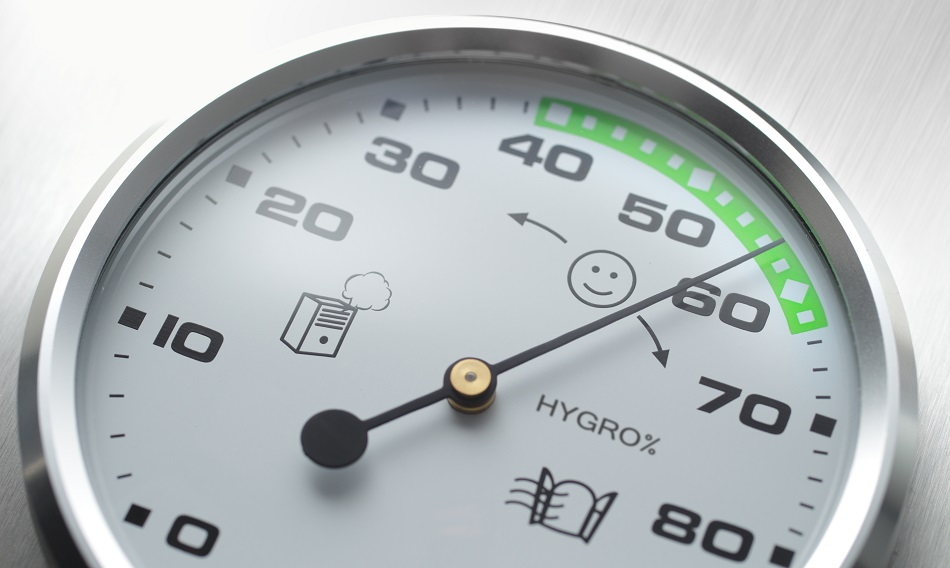By Kalwinder KaurJun 21 2012

Image Credit: peterschreiber.media/Shutterstock.com
Hygrometers are used to measure moisture content in the environment by considering temperature, pressure, mass, and the transfer of an electrical charge. Accurate measurement of humidity also relies on the calibration of the hygrometer. There are three types of hygrometer instruments, all engineered slightly differently, but all aim to produce a clear measurement of humidity content.
Capacitive Humidity Detector
A capacity humidity sensing device is designed with a polymer film sandwiched between metal conductive electrodes. These sensors are widely applied in industrial settings and are widely utilized as weather telemetry instruments.
.jpg)
Figure 1. Capacitor Structure.
The capacitive relative humidity (RH) sensor is formed by merging two conductive plates that sandwich an insulator referred to as a dielectric. Here, a capacitance is calculated by measuring the area of both plates, the length of space, and the dielectric coefficient. The purpose of the insulator is to absorb any water vapor diffusing through the RH sensor. A high shift in the electrical charge from an average equilibrium position is directly proportional to the relative humidity content in a sample.
Typically, a divergence in the capacitance from 0.2 to 0.5 pF is observable for a one per cent change in RH. Given this, bearing in mind that the electrical capacitance will be higher when the dielectric collects more water, the RH of the surrounding environment will therefore be proportional to the dielectric coefficient. Such capacitive humidity sensors are engineered to work in extreme temperatures and are resistant to chemical vapors.
Advantages
- Linear voltage output
- Works well under a wide temperature range and maintains condensation tolerance
- Ideal for long-term application
Disadvantages
- The distance between the humidity sensor and the signaling circuit is limited (cannot be applied to large open areas)
- Relatively more expensive than other hygrometers in the market
- Continuously needs a clean mirror for an accurate reading
Hair-Tension Humidity Sensors
Compared to the RH sensor, a more organic form of a typical humidity sensor is that of the hair tension hygrometer. This type of hygrometer uses animal hair mounted in clusters as sensing elements. Keeping the hair under tension increases the sensitivity of the hair to change in humidity, temperature, thus a direct change in the length of the hair can be measured by using a dial or scale. The tips of each hair are bundled together and held in position using a screw. The lower end of each hair is aligned and attached to an adjustable arm which keeps each hair under tension. The screw at the top end of this hygrometer is also adjustable for shifts.
Each hair to this device is approximately 200 to 300 mm in length. Any change in atmospheric temperature and humidity will change the length of each hair connected to an array of levers wired to a recording device. In response to a change in humidity, hair expands or contracts which displaces the movement of a hook. The movement of each hair is magnified which provides an accurate and linear measurement of relative humidity (RH) over 0 to 100%.
Advantages
- Utility in meteorological research
- Simple to use and navigate in a variety of applications
Disadvantages
- Magnified errors during rapid humidity changes
- Increased sensitivity to rapid changes in humidity (especially in extreme environments)
- Hair samples are prone to damage through continuous tension
Electronic Humidity Sensor
Modern-day humidity sensors are based on microprocessor-based circuitry. For example, the Dew point humidity sensor is stable and can be used over a long period of time. This type of sensor is dependent on the “dew point” – the temperature state that allows air moisture to saturate as vapor. A working principle for this type of sensor involves a mirror surface and optoelectronics to measure the amount of water vapor on the surface of the mirror. The temperature of this mirror is electronically monitored to help measure the dew point. A monolithic circuit is connected to the dew point sensor and provides an electrical wave proportional to RH which helps calculate vapor pressure.
Advantages
- High durability and resistance, especially to chemical vapors
- Applicable in extreme temperature environments
- Dew point measurement and relative temperature comparison feature
Disadvantages
- Not applicable to gases with thermal properties
- May be more complex and challenging to use
Applications for Humidity Sensors
Humidity sensors could be utilized in many applications and industries. Most commonly, hygrometers are used in meteorological research and environmental monitoring (e.g. to help restore environmentally sensitive rainforests); however, recently, there have been key empirical studies denoting its utility in the food processing industry, social health settings, automotive industry, medical field, consumer electronics, building technologies, and coating industry.
Sources and Further Reading
- Srivastava, G.P. (2008). Surface Meteorological Instruments and Measurement Practices. New Delhi: Atlantic Publishers and Distributors Ltd. 161–172.
- Wilson, J.S (2005). Sensor Technology. Handbook. Oxford: Elsevier Inc. 271–280.
- Mukhopadhyay, S.C., Huang, Y. (2008). Sensors. Advancements in Modelling, Design Issues, Fabrication and Practical Applications. Berlin: Springer. 153–154.
This article was updated on 17th February, 2020.
Disclaimer: The views expressed here are those of the author expressed in their private capacity and do not necessarily represent the views of AZoM.com Limited T/A AZoNetwork the owner and operator of this website. This disclaimer forms part of the Terms and conditions of use of this website.